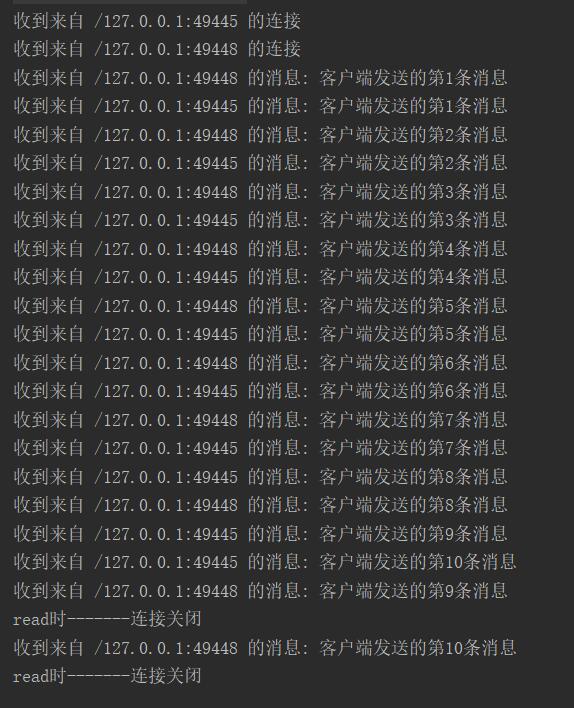一、Selector&Channel
写这个模型需要提前了解Selector以及Channel,之前记录过FileChannel,除此之外还有以下几种Channel:
ServerSocketChannel:用于监听新的TCP连接的通道,负责读取&响应,通常用于服务端的实现。
SocketChannel:用于发起TCP连接,读写网络中的数据,通常用于客户端的实现。
DatagramChannel:上述两个通道基于TCP传输协议,而这个通道则基于UDP,用于读写网络中的数据。
FileChannel:从文件读取数据。
本篇重点放在ServerSocketChannel和SocketChannel上,大部分客户端/服务端为了保证数据准确性,都是基于TCP传输协议实现的,由于使用Selector注册必须要求被注册的Channel是非阻塞模式的,因此FileChannel由于没有非阻塞模式(无法设置configureBlocking(false)),没办法和注册到selector。
Selector是个通道注册器(用法会在程序里标注),是实现Reactor模型的关键,多个通道均可以注册到Selector,Selector负责监听每个Channel的几个事件:连接就绪、写就绪、读就绪,当某个channel注册感兴趣就绪事件到selector时,若发生兴趣事件就绪,则Selector.select()方法不再阻塞,返回兴趣事件集合(可能包含多个channel的),然后按照事件不同进行分发处理。
Selector返回对应的就绪事件,封装为SelectionKey,每个Channel对应一个SelectionKey,这个对象还可以通过attach方法附着处理类(Handler、Acceptor等)。
先来看个简单使用Selector做处理的服务端实现,可以简单对Selector和SelectionKey的用法做个了解:
public static void main(String[] args) throws IOException {
Selector selector = Selector.open(); //打开选择器
ServerSocketChannel serverSocketChannel = ServerSocketChannel.open(); //打开通道
serverSocketChannel.configureBlocking(false); //设置通道为非阻塞模式
serverSocketChannel.bind(new InetSocketAddress(2333)); //绑定端口
serverSocketChannel.register(selector, SelectionKey.OP_ACCEPT); //注册channel到选择器,指定监听该Channel的哪些事件,初始化都是对连接事件监听(因为是入口)
while (selector.select() > 0) { // 若收到就绪事件select返回“感兴趣”事件集合,否则阻塞当前线程
Set keys = selector.selectedKeys(); //获取本次拿到的事件集合
Iterator iterator = keys.iterator();
while (iterator.hasNext()) {
SelectionKey key = iterator.next();
iterator.remove();
if (key.isAcceptable()) { //当前就绪事件为连接事件
ServerSocketChannel skc = (ServerSocketChannel) key.channel(); //连接就绪触发,说明已经有客户端通道连了过来,这里需要拿服务端通道去获取客户端通道
SocketChannel socketChannel = skc.accept(); //获取客户端通道(连接就绪,说明客户端接下来可能还有别的动作,比如读和写)
socketChannel.configureBlocking(false); //同样的需要设置非阻塞模式
System.out.println(String.format("收到来自 %s 的连接", socketChannel.getRemoteAddress()));
socketChannel.register(selector, SelectionKey.OP_READ); //将该客户端注册到选择器,感兴趣事件设置为读(客户端连接完毕,很肯能会往服务端写数据,因此这里要注册读事件用以接收这些数据)
} else if (key.isReadable()) { //当前事件为读就绪
SocketChannel socketChannel = (SocketChannel) key.channel(); //能触发读就绪,说明客户端已经开始往服务端写数据,通过SelectionKey拿到当前客户端通道
ByteBuffer buffer = ByteBuffer.allocate(1024);
int count = socketChannel.read(buffer); //从通道读入数据
if (count < 0) { //若本次读就绪拿到-1,则认为客户端主动断开了连接
socketChannel.close(); //服务端关闭客户端通道
key.cancel(); //断连后就将该事件从选择器的SelectionKey集合中移除(这里说一下,这里不是真正意义上的移除,这里是取消,会将该key放入取消队列里,在下次select函数调用时才负责清空)
System.out.println("连接关闭");
continue;
}
System.out.println(String.format("收到来自 %s 的消息: %s",
socketChannel.getRemoteAddress(),
new String(buffer.array())));
}
keys.remove(key);
}
}
}
上面是一个简单的例子,接下来,就利用选择器、通道来实现Reactor单线程模型。
二、单Reactor单线程模型的服务端实现
实现服务端,服务端负责接收客户端的连接,接收客户端的请求数据以及响应客户端。
把上一篇的结构图再拿过来展示下,看看需要做的有哪些模块:
图1
通过上图,我们需要实现的模块有Reactor、Acceptor、Handler,下面来逐个编写:
1.Reactor核心模块
该模块内部包含两个核心方法,select和dispatch,该模块负责监听就绪事件和对事件的分发处理:
public class Reactor implements Runnable {
private final Selector selector;
private final ServerSocketChannel serverSocketChannel;
public Reactor(int port) throws IOException { //Reactor初始化
selector = Selector.open(); //打开一个Selector
serverSocketChannel = ServerSocketChannel.open(); //建立一个Server端通道
serverSocketChannel.socket().bind(new InetSocketAddress(port)); //绑定服务端口
serverSocketChannel.configureBlocking(false); //selector模式下,所有通道必须是非阻塞的
//Reactor是入口,最初给一个channel注册上去的事件都是accept
SelectionKey sk = serverSocketChannel.register(selector, SelectionKey.OP_ACCEPT);
//attach callback object, Acceptor
sk.attach(new Acceptor(serverSocketChannel, selector));
}
@Override
public void run() {
try {
while (!Thread.interrupted()) {
selector.select(); //就绪事件到达之前,阻塞
Set selected = selector.selectedKeys(); //拿到本次select获取的就绪事件
Iterator it = selected.iterator();
while (it.hasNext()) {
//这里进行任务分发
dispatch((SelectionKey) (it.next()));
}
selected.clear();
}
} catch (IOException e) {
e.printStackTrace();
}
}
void dispatch(SelectionKey k) {
Runnable r = (Runnable) (k.attachment()); //这里很关键,拿到每次selectKey里面附带的处理对象,然后调用其run,这个对象在具体的Handler里会进行创建,初始化的附带对象为Acceptor(看上面构造器)
//调用之前注册的callback对象
if (r != null) {
r.run();
}
}
}
细节已标注。
2.接下来实现Acceptor模块
这个模块只负责处理连接就绪事件,有了这个事件就可以拿到客户单的SocketChannel,就可以继续完成接下来的读写任务了:
public class Acceptor implements Runnable {
private final Selector selector;
private final ServerSocketChannel serverSocketChannel;
Acceptor(ServerSocketChannel serverSocketChannel, Selector selector) {
this.serverSocketChannel = serverSocketChannel;
this.selector = selector;
}
@Override
public void run() {
SocketChannel socketChannel;
try {
socketChannel = serverSocketChannel.accept();
if (socketChannel != null) {
System.out.println(String.format("收到来自 %s 的连接",
socketChannel.getRemoteAddress()));
new Handler(socketChannel, selector); //这里把客户端通道传给Handler,Handler负责接下来的事件处理(除了连接事件以外的事件均可)
}
} catch (IOException e) {
e.printStackTrace();
}
}
}
细节已标注。
3.Handler模块的实现
这个模块负责接下来的读写操作:
public class Handler implements Runnable {
private final SelectionKey selectionKey;
private final SocketChannel socketChannel;
private ByteBuffer readBuffer = ByteBuffer.allocate(1024);
private ByteBuffer sendBuffer = ByteBuffer.allocate(2048);
private final static int READ = 0;
private final static int SEND = 1;
private int status = READ;
Handler(SocketChannel socketChannel, Selector selector) throws IOException {
this.socketChannel = socketChannel; //接收客户端连接
this.socketChannel.configureBlocking(false); //置为非阻塞模式(selector仅允非阻塞模式)
selectionKey = socketChannel.register(selector, 0); //将该客户端注册到selector,得到一个SelectionKey,以后的select到的就绪动作全都是由该对象进行封装
selectionKey.attach(this); //附加处理对象,当前是Handler对象,run是对象处理业务的方法
selectionKey.interestOps(SelectionKey.OP_READ); //走到这里,说明之前Acceptor里的建连已完成,那么接下来就是读取动作,因此这里首先将读事件标记为“感兴趣”事件
selector.wakeup(); //唤起select阻塞
}
@Override
public void run() {
try {
switch (status) {
case READ:
read();
break;
case SEND:
send();
break;
default:
}
} catch (IOException e) { //这里的异常处理是做了汇总,常出的异常就是server端还有未读/写完的客户端消息,客户端就主动断开连接,这种情况下是不会触发返回-1的,这样下面read和write方法里的cancel和close就都无法触发,这样会导致死循环异常(read/write处理失败,事件又未被cancel,因此会不断的被select到,不断的报异常)
System.err.println("read或send时发生异常!异常信息:" + e.getMessage());
selectionKey.cancel();
try {
socketChannel.close();
} catch (IOException e2) {
System.err.println("关闭通道时发生异常!异常信息:" + e2.getMessage());
e2.printStackTrace();
}
}
}
private void read() throws IOException {
if (selectionKey.isValid()) {
readBuffer.clear();
int count = socketChannel.read(readBuffer); //read方法结束,意味着本次"读就绪"变为"读完毕",标记着一次就绪事件的结束
if (count > 0) {
System.out.println(String.format("收到来自 %s 的消息: %s",
socketChannel.getRemoteAddress(),
new String(readBuffer.array())));
status = SEND;
selectionKey.interestOps(SelectionKey.OP_WRITE); //注册写方法
} else {
//读模式下拿到的值是-1,说明客户端已经断开连接,那么将对应的selectKey从selector里清除,否则下次还会select到,因为断开连接意味着读就绪不会变成读完毕,也不cancel,下次select会不停收到该事件
//所以在这种场景下,(服务器程序)你需要关闭socketChannel并且取消key,最好是退出当前函数。注意,这个时候服务端要是继续使用该socketChannel进行读操作的话,就会抛出“远程主机强迫关闭一个现有的连接”的IO异常。
selectionKey.cancel();
socketChannel.close();
System.out.println("read时-------连接关闭");
}
}
}
void send() throws IOException {
if (selectionKey.isValid()) {
sendBuffer.clear();
sendBuffer.put(String.format("我收到来自%s的信息辣:%s, 200ok;",
socketChannel.getRemoteAddress(),
new String(readBuffer.array())).getBytes());
sendBuffer.flip();
int count = socketChannel.write(sendBuffer); //write方法结束,意味着本次写就绪变为写完毕,标记着一次事件的结束
if (count < 0) {
//同上,write场景下,取到-1,也意味着客户端断开连接
selectionKey.cancel();
socketChannel.close();
System.out.println("send时-------连接关闭");
}
//没断开连接,则再次切换到读
status = READ;
selectionKey.interestOps(SelectionKey.OP_READ);
}
}
}
细节已标注。
关键模块已实现,下面来启动服务端:
new Thread(new Reactor(2333)).start();
三、客户端的编写
接下来同样利用selector编写客户端,客户端需要做的事情就是发送消息到服务端,等待服务端响应,然后再次发送消息,发够10条消息断开连接:
1.Client入口模块
public class NIOClient implements Runnable {
private Selector selector;
private SocketChannel socketChannel;
NIOClient(String ip, int port) {
try {
selector = Selector.open(); //打开一个Selector
socketChannel = SocketChannel.open();
socketChannel.configureBlocking(false); //设置为非阻塞模式
socketChannel.connect(new InetSocketAddress(ip, port)); //连接服务
//入口,最初给一个客户端channel注册上去的事件都是连接事件
SelectionKey sk = socketChannel.register(selector, SelectionKey.OP_CONNECT);
//附加处理类,第一次初始化放的是连接就绪处理类
sk.attach(new Connector(socketChannel, selector));
} catch (IOException e) {
e.printStackTrace();
}
}
@Override
public void run() {
try {
while (!Thread.interrupted()) {
selector.select(); //就绪事件到达之前,阻塞
Set selected = selector.selectedKeys(); //拿到本次select获取的就绪事件
Iterator it = selected.iterator();
while (it.hasNext()) {
//这里进行任务分发
dispatch((SelectionKey) (it.next()));
}
selected.clear();
}
} catch (IOException e) {
e.printStackTrace();
}
}
void dispatch(SelectionKey k) {
Runnable r = (Runnable) (k.attachment()); //这里很关键,拿到每次selectKey里面附带的处理对象,然后调用其run,这个对象在具体的Handler里会进行创建,初始化的附带对象为Connector(看上面构造器)
//调用之前注册的callback对象
if (r != null) {
r.run();
}
}
}
细节已标注。
2.Connector模块(建连)
public class Connector implements Runnable {
private final Selector selector;
private final SocketChannel socketChannel;
Connector(SocketChannel socketChannel, Selector selector) {
this.socketChannel = socketChannel;
this.selector = selector;
}
@Override
public void run() {
try {
if (socketChannel.finishConnect()) { //这里连接完成(与服务端的三次握手完成)
System.out.println(String.format("已完成 %s 的连接",
socketChannel.getRemoteAddress()));
new Handler(socketChannel, selector); //连接建立完成后,接下来的动作交给Handler去处理(读写等)
}
} catch (IOException e) {
e.printStackTrace();
}
}
}
细节已标注。
3.客户端Handler模块实现
public class Handler implements Runnable {
private final SelectionKey selectionKey;
private final SocketChannel socketChannel;
private ByteBuffer readBuffer = ByteBuffer.allocate(2048);
private ByteBuffer sendBuffer = ByteBuffer.allocate(1024);
private final static int READ = 0;
private final static int SEND = 1;
private int status = SEND; //与服务端不同,默认最开始是发送数据
private AtomicInteger counter = new AtomicInteger();
Handler(SocketChannel socketChannel, Selector selector) throws IOException {
this.socketChannel = socketChannel; //接收客户端连接
this.socketChannel.configureBlocking(false); //置为非阻塞模式(selector仅允非阻塞模式)
selectionKey = socketChannel.register(selector, 0); //将该客户端注册到selector,得到一个SelectionKey,以后的select到的就绪动作全都是由该对象进行封装
selectionKey.attach(this); //附加处理对象,当前是Handler对象,run是对象处理业务的方法
selectionKey.interestOps(SelectionKey.OP_WRITE); //走到这里,说明之前Connect已完成,那么接下来就是发送数据,因此这里首先将写事件标记为“感兴趣”事件
selector.wakeup(); //唤起select阻塞
}
@Override
public void run() {
try {
switch (status) {
case SEND:
send();
break;
case READ:
read();
break;
default:
}
} catch (IOException e) { //这里的异常处理是做了汇总,同样的,客户端也面临着正在与服务端进行写/读数据时,突然因为网络等原因,服务端直接断掉连接,这个时候客户端需要关闭自己并退出程序
System.err.println("send或read时发生异常!异常信息:" + e.getMessage());
selectionKey.cancel();
try {
socketChannel.close();
} catch (IOException e2) {
System.err.println("关闭通道时发生异常!异常信息:" + e2.getMessage());
e2.printStackTrace();
}
}
}
void send() throws IOException {
if (selectionKey.isValid()) {
sendBuffer.clear();
int count = counter.incrementAndGet();
if (count <= 10) {
sendBuffer.put(String.format("客户端发送的第%s条消息", count).getBytes());
sendBuffer.flip(); //切换到读模式,用于让通道读到buffer里的数据
socketChannel.write(sendBuffer);
//则再次切换到读,用以接收服务端的响应
status = READ;
selectionKey.interestOps(SelectionKey.OP_READ);
} else {
selectionKey.cancel();
socketChannel.close();
}
}
}
private void read() throws IOException {
if (selectionKey.isValid()) {
readBuffer.clear(); //切换成buffer的写模式,用于让通道将自己的内容写入到buffer里
socketChannel.read(readBuffer);
System.out.println(String.format("收到来自服务端的消息: %s", new String(readBuffer.array())));
//收到服务端的响应后,再继续往服务端发送数据
status = SEND;
selectionKey.interestOps(SelectionKey.OP_WRITE); //注册写事件
}
}
}
细节已标注。
下面启动客户端去连接之前的服务端:
new Thread(new NIOClient("127.0.0.1", 2333)).start();
new Thread(new NIOClient("127.0.0.1", 2333)).start();
上面模拟了两个客户端同时连到服务端,运行结果如下:
服务端运行结果:
图2
客户端运行结果如下:
图3
单线程Reactor模型有个致命的缺点,通过上述例子可以看出,整个执行流程都是线性的,客户端请求→服务端读取→服务端响应→客户端收到响应→客户端再次发送请求,那么在这个链路中,如果handler中某个位置存在性能瓶颈,比如我们可以改造下服务端的send方法:
try {
Thread.sleep(2000L); //响应2s
} catch (InterruptedException e) {
e.printStackTrace();
}
int count = socketChannel.write(sendBuffer);
在响应客户端之前睡眠2s,当做是性能瓶颈点,同样的再次开两个客户端同时访问服务端,每个客户端发送10条消息,会发现,程序直接运行了40s,这是大多数情况下不愿意看到的,因此,就有了多线程Reactor模式,跟BIO为了提高性能将读操作放到一个独立线程处理一样,Reactor这样做,也是为了解决上面提到的性能问题,只不过NIO比BIO做异步有个最大的优势就是NIO不会阻塞一个线程,类似read这种操作状态都是由selector负责监听的,不像BIO里都是阻塞的,只要被异步出去,那么一定是非阻塞的业务代码(除非是人为将代码搞成阻塞),而BIO由于read本身阻塞,因此会阻塞掉整个线程,这也是同样是异步为什么NIO可以更加高效的原因之一。
那么单线程Reactor适用于什么情况呢?适用于那种程序复杂度很低的系统,例如redis,其大部分操作都是非常高效的,很多命令的时间复杂度直接为O(1),这种情况下适合这种简单的Reactor模型实现服务端。


